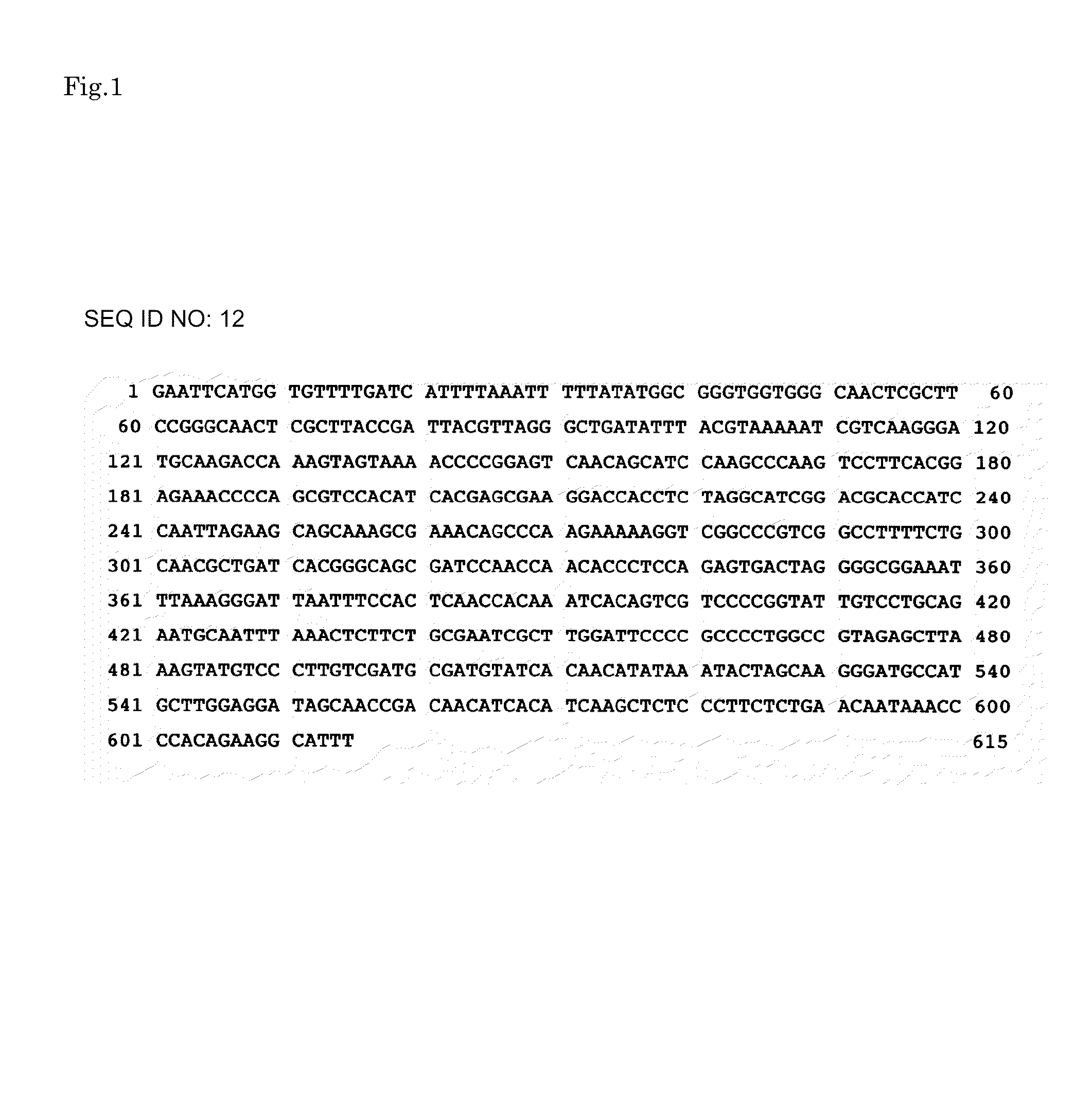Modified promoter
a promoter and modified technology, applied in the field of modified promoters, can solve the problems of low possibility of obtaining high expression promoters, and cannot say that such a sufficient expression property as to carry out the production of proteins can be obtained, so as to reduce catabolite repression for glucose, enhance expression, and reduce catabolite repression.
- Summary
- Abstract
- Description
- Claims
- Application Information
AI Technical Summary
Benefits of technology
Problems solved by technology
Method used
Image
Examples
example 1
Subcloning of Promoter Region
[0069]By using pTG-taa [Mol. Gene. Genet., 254, 119-126 (1997)] including 3164 bp of a Taka-amylase A gene (taaG2) of an Aspergillus oryzae strain JCM02239 [Gene, 84, 319-327 (1989)] as a starting material, a Taka-amylase A gene promoter region and a coding region of Taka-amylase A gene were prepared.
[0070]Firstly, from pTG-taa, 750bp of EcoRI-SalI fragment including a Taka-amylase A (taaG2) promoter region was obtained. This fragment was inserted into an EcoRI-SalI site of a multicloning site of a plasmid pKF18K (Toyobo Co., Ltd.) to obtain a plasmid pKF-taaP including a Taka-amylase promoter. Introducing mutation into a promoter region and the construction of the modified promoter region were carried out using this plasmid.
example 2
Obtaining DNA Fragment Including Binding Sequence of Transcriptional Regulation Factor
[0071]A fragment including a CCAAT sequence [Mol. Gen. Genet., 237, 251-260(1993)] that is a binding factor of a previously reported wide-domain transcription activation factor (HAP) and SRE [Mol. Gen. Genet., 262, 668-676(1999)] that is a binding factor of transcription activation factor of starch degrading enzyme gene cluster (AmyR) was obtained as follows.
[0072]Firstly, as a synthetic DNA in which an XhoI site was added to the 5′-end side and a NotI site was added to the 3′-end side of a CCAAT sequence, XNF (5′-CCGCTCGAGGCACCATCCAATTAGAAGCGCGGCCGCTAAACTAT3′: SEQ ID NO: 13), and as a complementary strand of this sequence, XNR (5′-ATAGTTTAGCGGCCGCGCTTCTAATTGGATGGTGCCTCGAGCGG-3′: SEQ ID NO: 14) were synthesized. Then, complementary strands of the synthetic DNAs were mixed with each other and heated at 98° C. for 10 minutes, then cooled down to 30° C. over two hours, and then cooled down to 4° C. fo...
example 3
Construction of Plasmid Including Modified Promoter
[0083]Introduction of mutation into a promoter region of a Taka-amylase A gene was carried out as follows. Firstly, in order to introduce a restriction enzyme site for modifying a promoter region into pKF-taaP prepared in Example 1, site-directed mutation was introduced into pKF-taaP using the below-mentioned primers and Mutan-Super Express Km Kit (TAKARA). Note here that FIG. 1 shows a sequence (SEQ ID NO: 12) of a wild type promoter; and FIG. 2 shows the position of the introduced restriction enzyme.
[0084]Primer for introducing NotI site into a down stream region (position 465 where a Taka-amylase promoter shown in SEQ ID NO: 12 is located)
[0085]
(SEQ ID NO: 21)Not-b:5′-CGCTTGGATTCCCCGCCCGCGGCCGCAGAGCTTAAAGTATGTCCC-3′
[0086]Primer for introducing XhoI site into a downstream region (position 440 where a Taka-amylase promoter shown in SEQ ID NO: 12 is located)
[0087]
(SEQ ID NO: 22)Xho-b:5′-GAATGCAATTTAAACTCTTCCTCGAGTCGCTTGGATTCCCCGCCC-...
PUM
| Property | Measurement | Unit |
|---|---|---|
| mass | aaaaa | aaaaa |
| structure | aaaaa | aaaaa |
| homogenous | aaaaa | aaaaa |
Abstract
Description
Claims
Application Information
 Login to View More
Login to View More - R&D
- Intellectual Property
- Life Sciences
- Materials
- Tech Scout
- Unparalleled Data Quality
- Higher Quality Content
- 60% Fewer Hallucinations
Browse by: Latest US Patents, China's latest patents, Technical Efficacy Thesaurus, Application Domain, Technology Topic, Popular Technical Reports.
© 2025 PatSnap. All rights reserved.Legal|Privacy policy|Modern Slavery Act Transparency Statement|Sitemap|About US| Contact US: help@patsnap.com



